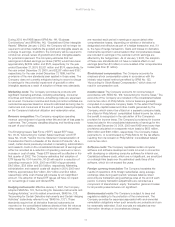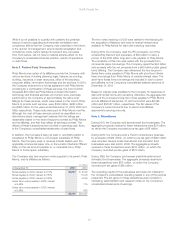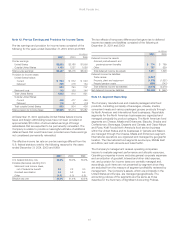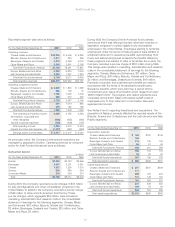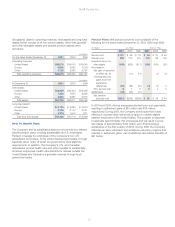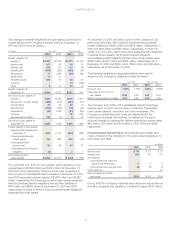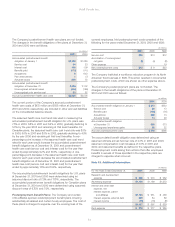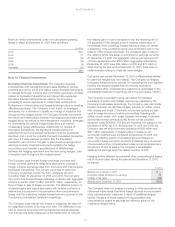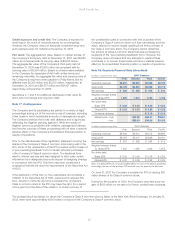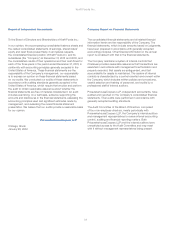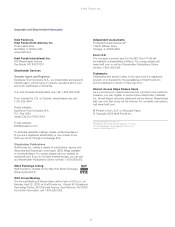Kraft 2001 Annual Report Download - page 60
Download and view the complete annual report
Please find page 60 of the 2001 Kraft annual report below. You can navigate through the pages in the report by either clicking on the pages listed below, or by using the keyword search tool below to find specific information within the annual report.
Kraft Foods Inc.
54
Minimum rental commitments under non-cancelable operating
leases in effect at December 31, 2001 were as follows:
(in millions)
2002 $212
2003 171
2004 135
2005 109
2006 86
Thereafter 136
$849
Note 16. Financial Instruments:
Derivative financial instruments: The Company operates
internationally, with manufacturing and sales facilities in various
locations around the world and utilizes certain financial instruments
to manage its foreign currency and commodity exposures, primarily
related to forecasted transactions and interest rate exposures.
Derivative financial instruments are used by the Company,
principally to reduce exposures to market risks resulting from
fluctuations in interest rates and foreign exchange rates by creating
offsetting exposures. The Company is not a party to leveraged
derivatives. For a derivative to qualify as a hedge at inception and
throughout the hedged period, the Company formally documents
the nature and relationships between the hedging instruments and
hedged items, as well as its risk-management objectives, strategies
for undertaking the various hedge transactions and method
of assessing hedge effectiveness. Additionally, for hedges of
forecasted transactions, the significant characteristics and
expected terms of a forecasted transaction must be specifically
identified, and it must be probable that each forecasted transaction
will occur. If it were deemed probable that the forecasted
transaction will not occur, the gain or loss would be recognized in
earnings currently. Financial instruments qualifying for hedge
accounting must maintain a specified level of effectiveness
between the hedging instrument and the item being hedged, both
at inception and throughout the hedged period.
The Company uses forward foreign exchange contracts and
foreign currency options to mitigate its exposure to changes in
foreign currency exchange rates from third-party and intercompany
forecasted transactions. The primary currencies to which the
Company is exposed include the Euro, Japanese yen and
Canadian dollar. At December 31, 2001 and 2000, the Company
had option and forward foreign exchange contracts with aggregate
notional amounts of $431 million and $237 million, respectively, for
the purchase or sale of foreign currencies. The effective portion of
unrealized gains and losses associated with forward contracts is
deferred as a component of accumulated other comprehensive
losses until the underlying hedged transactions are reported on the
Company’s consolidated statement of earnings.
The Company uses interest rate swaps to hedge the fair value of
an insignificant portion of its long-term debt. The differential to be
paid or received is accrued and recognized as interest expense.
If an interest rate swap agreement is terminated prior to maturity,
the realized gain or loss is recognized over the remaining life of
the agreement if the hedged amount remains outstanding, or
immediately if the underlying hedged exposure does not remain
outstanding. If the underlying exposure is terminated prior to the
maturity of the interest rate swap, the unrealized gain or loss on
the related interest rate swap is recognized in earnings currently.
At December 31, 2001, the aggregate notional principal amount
of those agreements was $102 million. Aggregate maturities at
December 31, 2001 were $29 million in 2003 and $73 million in
2004. During the year ended December 31, 2001, there was no
ineffectiveness relating to these fair value hedges.
During the year ended December 31, 2001, ineffectiveness related
to cash flow hedges was not material. The Company is hedging
forecasted transactions for periods not exceeding the next eighteen
months and expects substantially all amounts reported in
accumulated other comprehensive losses to be reclassified to the
consolidated statement of earnings within the next twelve months.
The Company is exposed to price risk related to forecasted
purchases of certain commodities used as raw materials by the
Company’s businesses. Accordingly, the Company uses commodity
forward contracts, as cash flow hedges, primarily for coffee, cocoa,
milk, cheese and wheat. Commodity futures and options are also
used to hedge the price of certain commodities, including milk,
coffee, cocoa, wheat, corn, sugar, soybean and energy. In general,
commodity forward contracts qualify for the normal purchase
exception under SFAS No. 133 and are, therefore, not subject to the
provisions of SFAS No. 133. At December 31, 2001 and 2000, the
Company had net long commodity positions of $589 million and
$617 million, respectively. Unrealized gains or losses on net
commodity positions were immaterial at December 31, 2001 and
2000. The effective portion of unrealized gains and losses on
commodity futures and option contracts is deferred as a component
of accumulated other comprehensive losses and is recognized as a
component of cost of sales in the Company’s consolidated
statement of earnings when the related inventory is sold.
Hedging activity affected accumulated other comprehensive losses,
net of income taxes, during the year ended December 31, 2001,
as follows:
(in millions)
Balance as of January 1, 2001 $
—
Derivative losses transferred to earnings 15
Change in fair value (33)
Balance as of December 31, 2001 $(18)
The Company does not engage in trading or other speculative use
of financial instruments. Derivative losses reported in accumulated
other comprehensive losses are a result of qualifying hedging
activity. Transfers of these losses from accumulated other
comprehensive losses to earnings are offset by gains on the
underlying hedged items.


